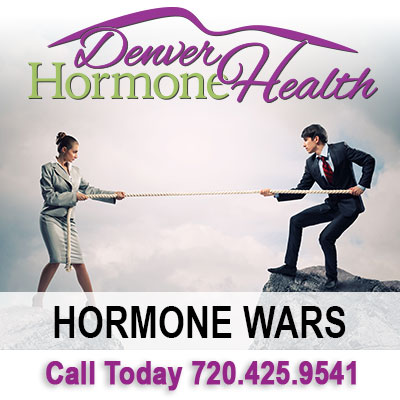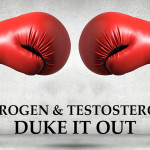TESTOSTERONE: HORMONE OF CHAMPIONS
 It’s a strange thing. When we mention the word “estrogen” people tend to think of aging menopausal women and a host of irritating symptoms that can drive both women and men crazy. But mention “testosterone” and it’s a whole different picture; young, hunky studs with six packs (well, at least 4 packs). Babe magnets. Not quite so simple, guys. Let’s take a closer look at this complex hormone.
It’s a strange thing. When we mention the word “estrogen” people tend to think of aging menopausal women and a host of irritating symptoms that can drive both women and men crazy. But mention “testosterone” and it’s a whole different picture; young, hunky studs with six packs (well, at least 4 packs). Babe magnets. Not quite so simple, guys. Let’s take a closer look at this complex hormone.
The body’s endocrine system consists of glands that manufacture hormones. The hypothalamus, located in the brain, tells the pituitary gland how much testosterone the body needs. The pituitary gland then sends the message to the testicles. Most testosterone is produced in the testicles, but small amounts come from the adrenal glands, which are located just above the kidneys. In women, the adrenal glands and ovaries produce small amounts of testosterone.
Before a boy is even born, testosterone is working to form male genitals. Testosterone production surges during adolescence and peaks in the late teens or early 20s. During puberty, rising levels of testosterone encourage the growth of the testicles and penis. As a man transitions from childhood to adulthood, testosterone begins to deepen his voice and spurs the growth of hair on the face, in the armpits, and around the genitals. Hair also may grow on the arms, legs, and chest. Testosterone is just one of many factors involved in the development of muscle bulk and strength. Testosterone increases neurotransmitters, which encourage tissue growth. It also interacts with nuclear receptors in DNA, which causes protein synthesis. Testosterone increases levels of growth hormones that play a part in making exercise more likely to build muscle. Testosterone increases bone density and tells the bone marrow to manufacture red blood Testosterone also plays a role in fat metabolism, helping men to burn fat more efficiently. So far, so good.
WHEN RAGING HORMONES START TO WHIMPER
When a woman is moody, it’s hormones. When a man is moody, it’s work stress or money problems or just one of those days. Andropause is in many ways similar to menopause. While not all men are affected by the natural decrease in testosterone that comes with age, a lot are, including about 25 million men in the United States alone. After age 30, most men begin to experience a gradual decline in testosterone,” says David Samadi, MD, chairman of the urology department at Lenox Hill Hospital in New York City. Then testosterone levels drop about one percent each year. About 4 out of 10 men over age 45 have low testosterone often referred to as “low T”. Although testosterone levels never reach zero (as estrogen levels do in women during menopause), declining testosterone levels can cause men to experience a host of symptoms they might not realize are due to low testosterone. “Low testosterone can also result when something happens like trauma or steroid use that prevents the testes from making the hormone,” says Bruce Gilbert, MD, PhD, an adjunct clinical professor of urology and reproductive medicine at Weill Cornell Medical College and director of reproductive and sexual medicine at the Smith Institute for Urology of the North Shore-LIJ Health System. In discussing low T, there can be some confusion in other ways it is referred to. One is “hypogonadism”, the other “andropause.”
HYPO WHAT?
Hypogonadism is a condition where testosterone is not being produced due to a physical abnormality of the testes or brain. It can also be due to an outside factor such as stress, poor diet or pre-existing health condition.
There are two basic types of hypogonadism:
- This type of hypogonadism — also known as primary testicular failure — originates from a problem in the testicles.
- This type of hypogonadism indicates a problem in the hypothalamus or the pituitary gland — parts of the brain that signal the testicles to produce testosterone. The hypothalamus produces gonadotropin-releasing hormone, which signals the pituitary gland to make follicle-stimulating hormone (FSH) and luteinizing hormone (LH). Luteinizing hormone then signals the testes to produce testosterone.
Either type of hypogonadism may be caused by an inherited (congenital) trait or something that happens later in life (acquired), such as an injury or an infection. At times, primary and secondary hypogonadism can occur together. According to the Mayo Clinic, hypogonadism can begin during fetal development, before puberty or during adulthood. Signs and symptoms depend on when the condition develops.
FETAL DEVELOPMENT
If the body doesn’t produce enough testosterone during fetal development, the result may be impaired growth of the external sex organs. Depending on when hypogonadism develops and how much testosterone is present, a child who is genetically male may be born with:
- Female genitals
- Ambiguous genitals — genitals that are neither clearly male nor clearly female
- Underdeveloped male genitals
PUBERTY
Male hypogonadism may delay puberty or cause incomplete or lack of normal development. It can cause:
- Decreased development of muscle mass
- Lack of deepening of the voice
- Impaired growth of body hair
- Impaired growth of the penis and testicles
- Excessive growth of the arms and legs in relation to the trunk of the body
- Development of breast tissue (gynecomastia)
ADULTHOOD
In adult males, hypogonadism may alter certain masculine physical characteristics and impair normal reproductive function. Signs and symptoms may include:
- Erectile dysfunction
- Infertility
- Decrease in beard and body hair growth
- Decrease in muscle mass
- Development of breast tissue (gynecomastia)
- Loss of bone mass (osteoporosis)
Hypogonadism can also cause mental and emotional changes. As testosterone decreases, some men may experience symptoms similar to those of menopause in women. These may include:
- Fatigue
- Decreased sex drive
- Difficulty concentrating
- Hot flashes
THIS OUGHT TO GIVE YOU PAUSE
First described medically in the 1940’s, andropause is a fairly common condition. Researchers at Northwestern Memorial Hospital have estimated that approximately five million men are affected by male menopause in the United States alone. Here’s the part that makes men cringe and women smile like Mona Lisa. Andropause is what is commonly referred to as “male menopause”. It is still the “change”. Men have it easier than women, but they still have it. The male menopause is much less abrupt than menopause. The signs and symptoms emerge more gradually and subtly, and the decrease in testosterone levels is nowhere near as estrogen is for women. When men reach their late forties to early fifties they may begin to experience symptoms (both physical and emotional) that bear some similarities to menopause.
- Irritable Male Syndrome
- Weight gain
- Sleep apnea
- Memory loss
- Diminished libido
- Hair Loss
- Erectile dysfunction
- Hot Flashes
- Muscle loss
- Depression
- Fatigue
- Night sweats in men
- Gynecomastia (male breasts)
Hoping it was all a myth, weren’t you?
The imbalance of even one hormone causes imbalance in other hormones and can lead to a domino effect of sorts. Men may not experience all of the above andropause symptoms, but instead commonly experience a combination of symptoms. While these symptoms are usually a result of andropause, they may also be symptoms of other conditions like adrenal fatigue and poor thyroid health. It is key to know where the symptoms originate.
MAYBE IT’S YOUR KNOWLEDGE THAT’S DYSFUNCTIONAL
O.K…here are the two words that strike terror in the minds of men of all ages.
ERECTILE DYSFUNTION.
(Shhhh…it’s also called “impotence”.)
Erections are triggered by the body’s release of a tiny molecule called nitric oxide. But testosterone is what’s needed to trigger this release, and if there’s not enough of it, well, it’s a no go. According to the Cleveland Clinic, as many as 52 percent of men experience erectile dysfunction, with it affecting 40 percent of men age 40, and 70 percent of men age 70. Previous research, led by physician-scientists at New York-Presbyterian Hospital/Weill Cornell Medical Center, revealed that 65 percent of men with ED are unable to have an orgasm, and 58 percent have problems with ejaculation. The causes are often the same as for andropause. There is definitely a link between all the conditions mentioned here. Sorting them out is the critical issue.
Aging, diabetes, high blood pressure, cardiovascular disease, cigarette smoking, substance abuse (alcohol included), nerve or spinal cord damage, medications to treat high blood pressure, antihistamines, antidepressants, antacids and of, course, low testosterone (that tricky hormone) can play a big part. Psychological factors may also be responsible including, stress, anxiety, depression, low self-esteem, posttraumatic stress disorder and fear of sexual performance. The more men think about it, the worse it gets. Men of all ages need to recognize this cycle and try to reduce the stress surrounding sex. It’s crazy. It’s been shown that the simple act of putting on a condom causes so much stress that it can actually lead to erectile dysfunction. Honest. One of the biggest psychological barriers is that unlike a woman getting treated for menopause, men more often than not avoid discussing the matter with a doctor. So they leave the problem untreated and often stay away from sex altogether.
Now why would you want to do something as drastic as that?
YOU WON’T FIND THE ANSWERS AT WALMART
It’s a testosterone marketing frenzy. Men want miracles and the drug companies are more than eager to be there for them. The figures are staggering. Billions are spent advertising testosterone as the “Fountain of Youth”. As demand skyrockets, so do the plethora of products. Products where the manufacturers, suppliers and even pharmacies get the big boost, not you. Patches, nasal creams, powders, gels applied to arms, armpits, and abdomen or inside of the thigh. You can get coupons, rebates and discounts (UP TO 75% OFF!). Are you kidding? Are you buying this?
ALL THE AMMUNTION YOU NEED
When your hormones are imbalance you just don’t feel like yourself. You don’t know what’s wrong, you just feel that something is out of whack. Well you’re not alone. Almost everyone experiences some symptoms of hormone imbalance in their lives. As you’ve seen, testosterone imbalances can cause a list of problems greater than you probably imagined. Certainly, they’re troubling. A safe way to balance testosterone is with bioidentical hormone replacement therapy or BHRT. Bioidentical hormones are structurally and molecularly identical to those naturally made in the human body. BHRT can be a huge help if administered by the right doctor.
IN THIS CASE, IT’S DR. STEPHEN A. GOLDSTEIN, M.D, F.A.C.S. AT DENVER HORMONE HEALTH. WHEN YOUR HORMONES ARE IMBALANCE, IT’S IMPERATIVE TO FIND THE RIGHT SOLUTION. WHEN IT COMES TO DISCUSSING ANY ISSUES YOU MIGHT BE EXPERIENCING, DR. GOLDSTEIN CAN PUT YOU TOTALLY AT EASE. WITH HIS EXTENSIVE EXPERIENCE AND EXPERTISE IN THE FIELD, HE KNOWS THAT TESTING AND COMPREHENSIVE EVALUATION OF YOUR RESULTS ARE CRITICAL FACTORS FOR SUCCESS. ONCE DETERMINING YOUR EXACT NEEDS, HE DEVELOPS AN INDIVIDUALIZED TREATMENT PROGRAM DESIGNED TO HELP RELIEVE AND IN MANY CASES ELIMINATE YOUR ISSUES.
THE ONE THING THAT ISN’T COMPLEX, IS THAT HIS HELP IS JUST A CALL AWAY. MAKE AN APPOINTMENT, COME IN, AND LET’S TALK.

